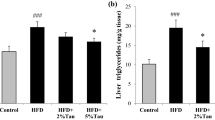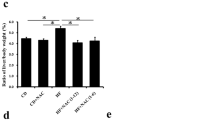Abstract
The Mediterranean diet is known for its cardioprotective effects. Recently, its protective qualities have also been reported in patients with non-alcoholic fatty liver disease (NAFLD). Oxidative stress is one of the important factors responsible for the development and progression of NAFLD. Hydrogen sulfide (H2S), a multifaceted gasotransmitter, has emerged as a potential therapeutic target in NAFLD. Cystathionine β-synthase (CBS) and cystathionine γ-lyase (CSE) are major enzymes responsible for endogenous H2S synthesis. Since oxidative stress contributes to NAFLD pathogenesis, the objective of this study was to investigate the effect of tyrosol, a major compound in olive oil and white wine, on high fat diet-induced hepatic oxidative stress and the mechanisms involved. Mice (C57BL/6) were fed for 5 weeks with a control diet (10 % kcal fat), a high fat diet (60 % kcal fat, HFD) or a HFD supplemented with tyrosol. High fat diet feeding induced hepatic oxidative stress, as indicated by the significant increase in lipid peroxidation and NADPH oxidase activity. Tyrosol supplementation significantly increased hepatic CBS and CSE expression and H2S synthesis in high fat diet-fed mice. Such effects were associated with the attenuation of high fat diet-induced hepatic lipid peroxidation and the restoration of the redox equilibrium of the antioxidant glutathione. Tyrosol also inhibited palmitic acid-induced oxidative stress in hepatocytes (HepG2 cells). These results suggest that the antioxidant properties of tyrosol may be mediated through functional changes in CBS and CSE activity, which might contribute to the hepatoprotective effect of the Mediterranean diet.




Similar content being viewed by others
Abbreviations
- ANOVA:
-
Analysis of variance
- AOAA:
-
Aminooxyacetic acid
- CBS:
-
Cystathionine β-synthase
- CSE:
-
Cystathionine γ-lyase
- GSH:
-
Reduced glutathione
- GSSG:
-
Oxidized glutathione
- H2S:
-
Hydrogen sulfide
- NAFLD:
-
Non-alcoholic fatty liver disease
- NASH:
-
Non-alcoholic steatohepatitis
- PAG:
-
dl-Propargylglycine
- ROS:
-
Reactive oxygen species
References
de Lorgeril M (2013) Mediterranean diet and cardiovascular disease: historical perspective and latest evidence. Curr Atheroscler Rep 15:370
Martinez-Gonzalez MA, Salas-Salvado J, Estruch R, Corella D, Fito M, Ros E, PREDIMED Investigators (2015) Benefits of the Mediterranean diet: insights from the PREDIMED study. Prog Cardiovasc Dis 58:50–60
Babio N, Toledo E, Estruch R, Ros E, Martinez-Gonzalez MA, Castaner O, Bullo M, Corella D, Aros F, Gomez-Gracia E et al (2014) Mediterranean diets and metabolic syndrome status in the PREDIMED randomized trial. CMAJ 186:E649–E657
Kontogianni MD, Tileli N, Margariti A, Georgoulis M, Deutsch M, Tiniakos D, Fragopoulou E, Zafiropoulou R, Manios Y, Papatheodoridis G (2014) Adherence to the Mediterranean diet is associated with the severity of non-alcoholic fatty liver disease. Clin Nutr 33:678–683
Ryan MC, Itsiopoulos C, Thodis T, Ward G, Trost N, Hofferberth S, O’Dea K, Desmond PV, Johnson NA, Wilson AM (2013) The Mediterranean diet improves hepatic steatosis and insulin sensitivity in individuals with non-alcoholic fatty liver disease. J Hepatol 59:138–143
Cohen JC, Horton JD, Hobbs HH (2011) Human fatty liver disease: old questions and new insights. Science 332:1519–1523
Adams LA, Angulo P (2005) Recent concepts in non-alcoholic fatty liver disease. Diabet Med 22:1129–1133
Sartorio A, Del Col A, Agosti F, Mazzilli G, Bellentani S, Tiribelli C, Bedogni G (2007) Predictors of non-alcoholic fatty liver disease in obese children. Eur J Clin Nutr 61:877–883
Anstee QM, Targher G, Day CP (2013) Progression of NAFLD to diabetes mellitus, cardiovascular disease or cirrhosis. Nat Rev Gastroenterol Hepatol 10:330–344
Targher G (2007) Non-alcoholic fatty liver disease as a determinant of cardiovascular disease. Atherosclerosis 190:18–19; author reply 20–21
Targher G, Arcaro G (2007) Non-alcoholic fatty liver disease and increased risk of cardiovascular disease. Atherosclerosis 191:235–240
Loomba R, Sanyal AJ (2013) The global NAFLD epidemic. Nat Rev Gastroenterol Hepatol 10:686–690
Kleiner DE, Berk PD, Hsu JY, Courcoulas AP, Flum D, Khandelwal S, Pender J, Pomp A, Roerig J, Machado LL et al (2014) Hepatic pathology among patients without known liver disease undergoing bariatric surgery: observations and a perspective from the longitudinal assessment of bariatric surgery (LABS) study. Semin Liver Dis 34:98–107
Chalasani N, Younossi Z, Lavine JE, Diehl AM, Brunt EM, Cusi K, Charlton M, Sanyal AJ (2012) The diagnosis and management of non-alcoholic fatty liver disease: practice guideline by the American Association for the Study of Liver Diseases, American College of Gastroenterology, and the American Gastroenterological Association. Hepatology 55:2005–2023
Day CP, James OF (1998) Steatohepatitis: a tale of two “hits”? Gastroenterology 114:842–845
Berson A, De Beco V, Letteron P, Robin MA, Moreau C, El Kahwaji J, Verthier N, Feldmann G, Fromenty B, Pessayre D (1998) Steatohepatitis-inducing drugs cause mitochondrial dysfunction and lipid peroxidation in rat hepatocytes. Gastroenterology 114:764–774
Rolo AP, Teodoro JS, Palmeira CM (2012) Role of oxidative stress in the pathogenesis of nonalcoholic steatohepatitis. Free Radic Biol Med 52:59–69
Sarna LK, Wu N, Wang P, Hwang SY, Siow YL (2012) Folic acid supplementation attenuates high fat diet induced hepatic oxidative stress via regulation of NADPH oxidase. Can J Physiol Pharmacol 90:155–165
Hardwick RN, Fisher CD, Canet MJ, Lake AD, Cherrington NJ (2010) Diversity in antioxidant response enzymes in progressive stages of human nonalcoholic fatty liver disease. Drug Metab Dispos 38:2293–2301
Sarna LK, Siow YL (2015) The CBS/CSE system: a potential therapeutic target in NAFLD? Can J Physiol Pharmacol 93:1–11
Miro-Casas E, Covas MI, Fito M, Farre-Albadalejo M, Marrugat J, de la Torre R (2003) Tyrosol and hydroxytyrosol are absorbed from moderate and sustained doses of virgin olive oil in humans. Eur J Clin Nutr 57:186–190
Larter CZ, Yeh MM (2008) Animal models of NASH: getting both pathology and metabolic context right. J Gastroenterol Hepatol 23:1635–1648
Nakamura A, Terauchi Y (2013) Lessons from mouse models of high-fat diet-induced NAFLD. Int J Mol Sci 14:21240–21257
de la Torre-Robles A, Rivas A, Lorenzo-Tovar ML, Monteagudo C, Mariscal-Arcas M, Olea-Serrano F (2014) Estimation of the intake of phenol compounds from virgin olive oil of a population from southern Spain. Food Addit Contam Part A Chem Anal Control Expo Risk Assess 31:1460–1469
Franco MN, Galeano-Diaz T, Lopez O, Fernandez-Bolanos JG, Sanchez J, De Miguel C, Gil MV, Martin-Vertedor D (2014) Phenolic compounds and antioxidant capacity of virgin olive oil. Food Chem 163:289–298
Joshi-Barve S, Barve SS, Amancherla K, Gobejishvili L, Hill D, Cave M, Hote P, McClain CJ (2007) Palmitic acid induces production of proinflammatory cytokine interleukin-8 from hepatocytes. Hepatology 46:823–830
Feldstein AE, Werneburg NW, Canbay A, Guicciardi ME, Bronk SF, Rydzewski R, Burgart LJ, Gores GJ (2004) Free fatty acids promote hepatic lipotoxicity by stimulating TNF-alpha expression via a lysosomal pathway. Hepatology 40:185–194
Wu N, Sarna LK, Hwang SY, Zhu Q, Wang P, Siow YL, Karmin O (2013) Activation of 3-hydroxy-3-methylglutaryl coenzyme A (HMG-CoA) reductase during high fat diet feeding. Biochim Biophys Acta 1832:1560–1568
Giovannini C, Straface E, Modesti D, Coni E, Cantafora A, De Vincenzi M, Malorni W, Masella R (1999) Tyrosol, the major olive oil biophenol, protects against oxidized-LDL-induced injury in Caco-2 cells. J Nutr 129:1269–1277
Hourihan JM, Kenna JG, Hayes JD (2013) The gasotransmitter hydrogen sulfide induces Nrf2-target genes by inactivating the keap1 ubiquitin ligase substrate adaptor through formation of a disulfide bond between cys-226 and cys-613. Antioxid Redox Signal 19:465–481
Yang T, Zhang A, Honeggar M, Kohan DE, Mizel D, Sanders K, Hoidal JR, Briggs JP, Schnermann JB (2005) Hypertonic induction of COX-2 in collecting duct cells by reactive oxygen species of mitochondrial origin. J Biol Chem 280:34966–34973
Srisook K, Kim C, Cha YN (2005) Cytotoxic and cytoprotective actions of O2- and NO (ONOO-) are determined both by cellular GSH level and HO activity in macrophages. Methods Enzymol 396:414–424
Stipanuk MH, Beck PW (1982) Characterization of the enzymic capacity for cysteine desulphhydration in liver and kidney of the rat. Biochem J 206:267–277
Xu Z, Prathapasinghe G, Wu N, Hwang SY, Siow YL, Karmin O (2009) Ischemia-reperfusion reduces cystathionine-beta-synthase-mediated hydrogen sulfide generation in the kidney. Am J Physiol Renal Physiol 297:F27–F35
Hwang SY, Sarna LK, Siow YL (2013) High-fat diet stimulates hepatic cystathionine beta-synthase and cystathionine gamma-lyase expression. Can J Physiol Pharmacol 91:913–919
Lu SC (2009) Regulation of glutathione synthesis. Mol Aspects Med 30:42–59
Wu N, Siow YL , Karmin O (2010) Ischemia/reperfusion reduces transcription factor Sp1-mediated cystathionine beta-synthase expression in the kidney. J Biol Chem 285:18225–18233
Wang P, Isaak CK, Siow YL, Karmin O (2014) Downregulation of cystathionine beta-synthase and cystathionine gamma-lyase expression stimulates inflammation in kidney ischemia-reperfusion injury. Physiol Rep 2:e12251
Sanyal AJ, Chalasani N, Kowdley KV, McCullough A, Diehl AM, Bass NM, Neuschwander-Tetri BA, Lavine JE, Tonascia J, Unalp A et al (2010) Pioglitazone, vitamin E, or placebo for nonalcoholic steatohepatitis. N Engl J Med 362:1675–1685
Covas MI, de la Torre R, Fito M (2015) Virgin olive oil: a key food for cardiovascular risk protection. Br J Nutr 113(Suppl 2):S19–S28
Gutierrez VR, de la Puerta R, Catala A (2001) The effect of tyrosol, hydroxytyrosol and oleuropein on the non-enzymatic lipid peroxidation of rat liver microsomes. Mol Cell Biochem 217:35–41
Di Benedetto R, Vari R, Scazzocchio B, Filesi C, Santangelo C, Giovannini C, Matarrese P, D’Archivio M, Masella R (2007) Tyrosol, the major extra virgin olive oil compound, restored intracellular antioxidant defences in spite of its weak antioxidative effectiveness. Nutr Metab Cardiovasc Dis 17:535–545
Wang P, Zhu Q, Wu N, Siow YL, Aukema H, Karmin O (2013) Tyrosol attenuates ischemia-reperfusion-induced kidney injury via inhibition of inducible nitric oxide synthase. J Agric Food Chem 61:3669–3675
Tomas-Barberan FA, Somoza V, Finley J (2012) Food bioactives research and the Journal of Agricultural and Food Chemistry. Symposium introduction. J Agric Food Chem 60:6641–6643
Mateos R, Goya L, Bravo L (2005) Metabolism of the olive oil phenols hydroxytyrosol, tyrosol, and hydroxytyrosyl acetate by human hepatoma HepG2 cells. J Agric Food Chem 53:9897–9905
Huang T, Hu X, Khan N, Yang J, Li D (2013) Effect of polyunsaturated fatty acids on homocysteine metabolism through regulating the gene expressions involved in methionine metabolism. Sci World J 2013:931626
Huang T, Wahlqvist ML, Li D (2012) Effect of n-3 polyunsaturated fatty acid on gene expression of the critical enzymes involved in homocysteine metabolism. Nutr J 11:6
Acknowledgments
This study was supported, in part, by the Natural Sciences and Engineering Research Council of Canada, St. Boniface Hospital Foundation and Manitoba Health Research Council.
Author information
Authors and Affiliations
Corresponding author
About this article
Cite this article
Sarna, L.K., Sid, V., Wang, P. et al. Tyrosol Attenuates High Fat Diet-Induced Hepatic Oxidative Stress: Potential Involvement of Cystathionine β-Synthase and Cystathionine γ-Lyase. Lipids 51, 583–590 (2016). https://doi.org/10.1007/s11745-015-4084-y
Received:
Accepted:
Published:
Issue Date:
DOI: https://doi.org/10.1007/s11745-015-4084-y




